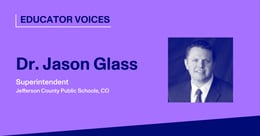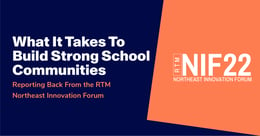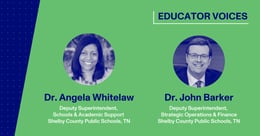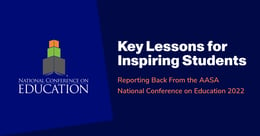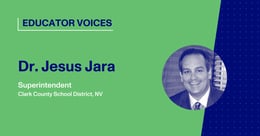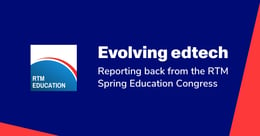
5 Questions With Kaweeda G. Adams
As life returns to normal, the question on all educators' minds is, "What can we take from this experience to improve our effectiveness going forward?" The team behind the City School District of Albany has built an equitable foundation by addressing teacher needs, tackling food insecurity, giving access to devices, and making the most of funding.
What strides has your district made in tackling educational equity gaps since last March?
When we needed to shift in March of 2020, we dealt with food insecurity right away. We made sure to continue providing lunches and weekend backpacks to our students. We also have a clinic at each of our community schools. We were able to look at that healthcare disparity and provide our students with tele-healthcare. We partnered with Whitney Young, Albany Med, and medical institutions and facilities that helped us close some of that divide when it came to healthcare.
We also dealt with the digital divide. We were not at a one-to-one status when we shifted to virtual learning, but we committed to ensuring every household had a device. We knew that there were families who may have had one child or multiple children, but at least each household—to level that playing field—had at least one device. We built our schedules so that if students were sharing computers, they could access their assignments at different times throughout the day.
Our Technology Division spearheaded our application for a New York State Smart Schools Grant to support the purchase of approximately 5,000 Chromebooks. Like most other school districts, national and international production and delivery delays in the first months of the pandemic challenge our ability to get to a one-to-one computing model for all students.
However, our community partners really stepped up to the plate. They were able to provide and refurbish computers, and the beauty of this was that they didn't donate them to the district—they donated them directly to families. We are now one-to-one with our computers, which was huge for us in closing the digital divide. We were also able to partner with several companies to get hotspots. We had roughly 1,100 hotspots, and each could hold about five connections. We just participated in another partnership to further close that gap with students getting internet access, and all of this is free of charge to our families.
How are you prioritizing educational equity gaps in 2021?
Being a district predominantly of people of color, equity is at the forefront of our decision-making. In 2019, our Board of Education adopted our first-ever equity policy, and we started looking at culturally relevant teaching and learning practices. Then we moved into that awareness of where we all stand with our unconscious biases that create gaps in learning for our students. But also taking it one step further, looking systemically at, "What are those things that we are doing in our policies and in our procedures that create systemic barriers for our children?"
We have equity teams at each of our schools that will start reviewing policies through an equity lens to ensure that our practices and procedures align with what we say, think, feel, and believe about equity. For us, equity is about removing those systemic barriers that prevent students from being successful and making sure that our students have what they need to be successful.
Access to grade-level material is a massive equity issue. The student may not be performing at grade level, but that doesn't mean that the student should be denied grade-level material. We need to use our teaching strategies and pull those tools out of our toolkit to adjust that information to meet the child's needs. We need to make sure that they are accessing grade-level material.
We're also asking the reflective questions about: How do we actualize student voice at all grade levels? How are we actualizing student voice so that our students learn how to advocate for themselves? How do we take that advocacy and move it forward in meaningful ways to make positive change? That is how our students become engaged with equity through a social justice lens.
See the City School District of Albany's Actualizing Equity series here.
How are you prioritizing current one-time state and federal funds to propel your district's long-term strategic goals and objectives?
We're looking at assessment, engagement, and socioemotional well-being data to make our decisions. Our counselors are asking, "What are the kinds of programs that we need to incorporate to address social and emotional learning?" We want it to be systemic; we don't want it to be a one-and-done because we know that that doesn't do anything for the long haul.
What we're trying to do is prioritize resources for those things that are truly one-time funds. For example, when we talk about purchasing technology, that may be a one-time expense. So, we're going to prioritize that. We're also planning our summer school enrichment program. There's an academic component, but many students come to school for enrichment activities such as music, art, robotics, and theater. It's what motivates them.
So we're looking at expanding our music and sports activities, enhancing our afterschool programs to include project-based learning, and making things more exciting and engaging for our students. We want to accelerate the learning versus just closing the gap. Learning may not have been lost. However, students may not be as far along as they ordinarily may have been in a traditional setting—but they may not have regressed. So, our challenge is closing the achievement gap in a way that accelerates learning, so that we can get our students to grade level or beyond.
Finally, we're looking at our HVAC systems. There are some enhancements that we can make to our schools' ventilation and filtration. Some of our buildings are very old, so we want to make sure that we take advantage of this opportunity to accelerate some of that ventilation and filtration enhancement that needs to happen.
How are you ensuring teacher satisfaction and well-being?
We have looked at our Employee Assistance Program and made that information available for our employees, and we have self-care mini-lessons before and after work through Starr Commonwealth. We have partnerships with the American Heart Association and the American Cancer Society so that our staff can learn how to practice self-care.
On our last PD day, we focused on mindfulness activities for our teachers, staff, and administrators. We also looked at financial literacy and wellness for our employees. I think it is vital that we don't forget that this is not just teachers; it is all of our employees. We have to make sure that they are in the right frame of mind to meet the needs of our students.
One challenge is making sure that people are taking advantage of those resources because there is still a stigma attached to mental health, and we're trying to break that stigma down. All of our lives have been heavily impacted by COVID-19 in different ways. There have been countless changes over the last year, and it can be very difficult for people to adjust. Receiving help to navigate and manage that is crucial.
Can you share one takeaway from the crisis and how you're applying it to help create the future of education?
All of our families have had some type of hardship, and the stress on our community has been unbelievable. One of the takeaways that I think is important to recognize is that, through all of this, we have learned about innovation due to necessity. We've had to reinvent due to necessity. Now, it's about taking that reinvention, taking that innovation, and asking, "How do we move that forward into opportunities for growth and progress for our students?"
We can turn all of our challenges into opportunities to make our students, faculty, and staff stronger, and to help us be able to think differently about how to accomplish our goals in education. I don't mean education solely in terms of academics. I mean that comprehensive, well-rounded education, and how we do things differently to promote opportunities to meet the needs of our students after all that we have learned through the pandemic.
This interview, edited for clarity and length, is part of a series with educational leaders to highlight their perspectives on the changing realities of education.
If you like hearing about how district leaders are tackling today's challenges in education, join these four superintendents on June 15 for a discussion on maximizing equity and impact for all.

